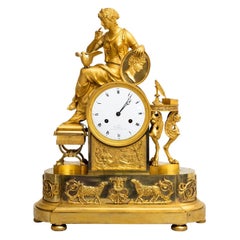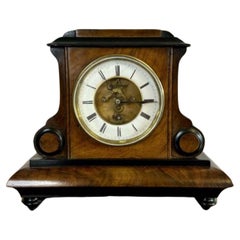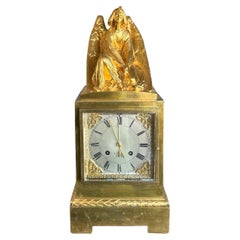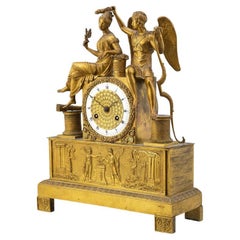Early 19th Century Mantel Clocks
to
59
300
125
1,653
405
38
241
91
42
58
19
48
28
8
6
10
12
10
7
130
18
12
11
7
4
1
1
1
1
275
199
111
87
63
200
54
271
241
21
17
5
Height
to
Width
to
300
300
300
3
2
2
2
2
Period: Early 19th Century
19th Century Gold French Empire Gilded Bronze Table Clock, Antique Pendule
Located in West Palm Beach, FL
A gold, antique French table clock, pendulum made of hand crafted fire-gilded bronze, in good condition. The circular enamel dial of the Pa...
Category
French Empire Antique Early 19th Century Mantel Clocks
Materials
Metal, Bronze
Early 19th Century French Mantel Clock, signed Ferey au Havre, Ormolu
Located in Greven, DE
Small mantel clock with bas-relief
France
Bronze, enamel
early 19th century
Dimensions: H x W x D: 33 x 19 x 9 cm
Description:
Antique, fire-gilt portal clock with figurative, Gre...
Category
French Empire Antique Early 19th Century Mantel Clocks
Materials
Bronze, Enamel, Ormolu
Stunning antique Victorian quality burr walnut mantle clock
Located in Ipswich, GB
Stunning antique Victorian quality burr walnut mantle clock, having a quality burr walnut case with carved scrolls, circular dial with Roman numerals ...
Category
Early Victorian Antique Early 19th Century Mantel Clocks
Materials
Brass
Gilt Bronze Gothic Revival Table Clock w. Earth Angel Sculpture by Devaulx Paris
By devaulx
Located in Lisse, NL
Rare and wonderful antique clock from the early 1800s. Marked: S. Devaulx, Paris.
Having an impressive, stylish and sizable antique clock like this gracing your mantel piece or sid...
Category
French Gothic Revival Antique Early 19th Century Mantel Clocks
Materials
Brass, Bronze
Early 19th Century Ormolu Mantel Clock, Atala freeing Chactas, Paris, circa 1810
Located in Greven, DE
Mantel Clock "Atala and Chactas"
Paris
Bronze (fire-gilt and patinated), enamel
Empire around 1810
Dimensions: H x W x D: 40 x 32 x 11 cm
Description:
Very rare and extremely high quality French mantel clock, so-called Pendule Au Bon Sauvage.
Depicted are scenes from the love story "Atala or the love of two savages in the desert" written by Francois René Vicomte de Chateaubriand in 1801. At the beginning of the 19th century, this was probably the most famous love story in Europe, but today it has been forgotten.
The story, set in present-day Louisiana (USA), is roughly rewritten about the forbidden love between Chactas, a young Indian, and Atala, the beautiful daughter of a Spaniard.
Chactas is captured in a battle between two Indian tribes, chained to a palm tree and is to be sacrificed. Atala wants to save his life and convert him to Christianity. She unties him from the palm tree at night and they flee together into the wilderness of North America. Their love for each other grows stronger and stronger and they have prospects for a future together.
The story takes a tragic turn when Atala, who must remain a virgin due to a vow made by her mother, can no longer withstand the conflict of her feelings and commits suicide.
The main group of characters thus shows Chacta's liberation through Atala. Atala is leaning against a pile of logs. The animal fur thrown over the logs and the weapons leaning against the stack on the right give the impression of a night camp.
The bronze is of rarely beautiful quality, finely chiselled and makes the scene appear very lively. The contrast of fire-gilded and patinated bronze adds tension to the composition.
In the base we see the Entombment as the end of the tragic love story. This bronze work is also very detailed, the interplay of bright and matt gilding makes the flat relief appear much deeper than it is.
The depiction of the mantel clock presented here shows that the exotic was only known from stories and that the bronzier had his own ideas about the appearance of this distant world. The Indian, for example, has very European facial features and his skin was not black in reality, of course. The palm tree was also certainly not found in the North American wilderness.
The heart of the clock is a French pendulum movement, integrated into the wooden pile, with an eight-day power reserve and a lock plate striking a bell on the half and full hour. The pendulum is suspended on a thread, typical of the period. The classically shaped hands, so-called Breguet hands, are also typical of the time.
The enamelled dial has black Roman hour numerals, Arabic quarter hours and bears the signature: Le Roy hr. de Madame A PARIS.
Interesting facts:
The period from 1795 to about 1815 saw the creation of probably the most spectacular group of bronzes: The "Au bon Sauvage" pendulums - depictions of the "Noble Savage".
Today's viewers react to these objects with both fascination and irritation. Enthusiastic on the one hand about the obvious quality of the detailed bronzes and the allure of the exotic, on the other hand distanced and cautious because of the possible discrimination that is suspected behind them. The ambivalence of this feeling motivates the search for the conditions of origin of these pendulums.
Europeans found their new ideal of the natural man primarily in fictional and realistic travelogues about the Indians of North America...
Category
French Empire Antique Early 19th Century Mantel Clocks
Materials
Ormolu
Gilt French Empire Table Clock, Early 1800s
Located in New York, NY
A French Empire table clock, first half of the 19th century.
Measures: Width 30, depth 11, height 38 cm. Key included.
Later added hatch at back. F...
Category
French Empire Antique Early 19th Century Mantel Clocks
Materials
Brass
Elegant quality 19th century French gilt metal and porcelain clock
Located in Ipswich, GB
Elegant quality French 19th century gilt metal and porcelain mantle clock, having a quality antique Victorian mantle clock with a beautiful blue and white porcelain dial decorated wi...
Category
French Antique Early 19th Century Mantel Clocks
Materials
Metal
A Quality Victorian Marble Mantle Clock
Located in Ipswich, GB
A quality Victorian Marble mantle clock with black Roman numerals with a white enamel face, the bronzed figural case surmounted by an Elizabeth...
Category
Victorian Antique Early 19th Century Mantel Clocks
Materials
Marble, Bronze
Fantastic quality large antique Victorian mantle clock
Located in Ipswich, GB
Fantastic quality large antique Victorian mantle clock, having outstanding quality gilded mounts of classical figures of a lady, cherub ...
Category
Victorian Antique Early 19th Century Mantel Clocks
Materials
Marble
Exquisite French Empire Ormolu and Cut-Crystal Clock, c. 1815
Located in Queens, NY
An exquisite French Empire ormolu and cut-crystal clock, c. 1815, attributed to Baccarat.
Made from the finest quality mercury gilding ormolu, this c...
Category
French Empire Antique Early 19th Century Mantel Clocks
Materials
Crystal, Ormolu
Antique Victorian quality marble eight day mantle clock
Located in Ipswich, GB
Antique Victorian quality marble eight day mantle clock having a quality black marble mantle clock with ornate gilded brass mounts, circular ornate brass dial with the original hands...
Category
Victorian Antique Early 19th Century Mantel Clocks
Materials
Marble, Brass
Empire Mantel Clock with Putto in Chariot, signed Thiery à Paris, Early 19th C.
Located in Greding, DE
Empire mantel clock made of fire-gilded bronze. The scene shows a putto in a richly decorated chariot pulled by a jumping poodle. The clockwork is elegantly integrated into the wheel...
Category
French Empire Antique Early 19th Century Mantel Clocks
Materials
Bronze
Outstanding quality large antique mantle clock
Located in Ipswich, GB
Outstanding quality large antique marble mantle clock, Having an outstanding quality marble case with green columns and gold detail, with an 8 day movement striking the hour & half h...
Category
Early Victorian Antique Early 19th Century Mantel Clocks
Materials
Marble
Mantel Clock with Apollo, Early 19th Century
Located in Greding, DE
Large fire-gilded bronze pendulum clock on lion's paws with a rectangular pedestal featuring lyre and torch motifs. Above it rises the full-figure depiction of the god Apollo with a ...
Category
French Neoclassical Antique Early 19th Century Mantel Clocks
Materials
Bronze
c1800 French Rococo Louis XV Mercury Gilt Bronze Figural Clock Case / Frame
Located in Opa Locka, FL
c1800 French Antique Rococo Louis XVI Mercury Gilt Bronze Figural Clock Case/ Frame. This period clock case is quite stunning, in excellent condition retaining the original gold pati...
Category
French Louis XVI Antique Early 19th Century Mantel Clocks
Materials
Bronze
French Empire Period Marble and Ormolu Clock, Early 19th Century
Located in Hamilton, Ontario
Early 19th century French Empire period marble and ormolu clock.
French Carrara marble Portico clock with extensive ormolu fretwork mounted on two finely decorated marble columns ...
Category
French Empire Antique Early 19th Century Mantel Clocks
$10,795 Sale Price
20% Off
Antique Empire Gold Gilt Patinated Bronze Ormolu Mantel Clock
Located in London, GB
Antique Empire Gold Gilt Patinated Bronze Ormolu Mantel Clock
French, c. 1810
Height 48cm, width 31cm, depth 20cm
A superb example of early 19th-century French decorative arts, thi...
Category
French Empire Antique Early 19th Century Mantel Clocks
Materials
Bronze, Enamel
$11,258 Sale Price
30% Off
Empire Portal Clock, France, Early 19th Century
Located in Greding, DE
Portal clock on a rectangular, stepped base in mahogany veneered with small bun feet. The stepped architrave is supported by four smooth columns, the capi...
Category
French Empire Antique Early 19th Century Mantel Clocks
Materials
Bronze
$3,592 Sale Price
20% Off
Large French Empire Period Gilt Bronze Figural Mantel Clock of Exceptional Quali
Located in Benington, Herts
A large and impressive French Empire period gilt bronze mantel clock of exceptional quality and colour.
French (possibly retailed in Italy) - Circa 1820.
The finely chased and original gilt bronze case depicting Orpheus playing his lyre with an eight-day bell striking movement, outside countwheel, backplate initialled and numbered 'A C D 1516’.
The dial with Roman numerals and inscribed Riccardo Pacinoti of Lavourne. It is a French movement (silk suspension) striking the hour and half hour. The case in the form of an oblong pillar cast with anthemium and cornucopia beneath a draped urn and a laurel wreath, flanked by the figure of Orpheus playing his lyre, the stepped plinth cast with wonderfully detailed underworld scenes, on leaf scroll feet.
In excellent condition the clock case has been cleaned with the movement completely overhauled and serviced to the highest standard by a specialist restorer.
In general 19th century French bronze clocks...
Category
French Empire Antique Early 19th Century Mantel Clocks
Materials
Bronze
Empire Ormolu and Patinated Bronze Figural Clock
Located in Kittery Point, ME
In the form of a putto with a wheel barrow carrying a keg mounted with a clock face topped by a crane, on a rectangular chased plinth ending in bun feet.
Category
French Empire Antique Early 19th Century Mantel Clocks
Materials
Bronze
$8,000 Sale Price
20% Off
Early 19th Century Empire Ormolu-Mounted Bronze and Marble Mantel Clock
Located in New York, NY
A fine quality empire ormolu-mounted patinated bronze and rouge royale marble mantel clock.
The patinated bronze figures depicting cupid and psyche. Attributed to Pierre-Victor Ledure...
Category
French Empire Antique Early 19th Century Mantel Clocks
Materials
Marble, Ormolu, Bronze
French Empire Bronze Clock Depicting Urania Greek Muse of Astronomy
By Lesieur
Located in Vancouver, British Columbia
A magnificent large gilded and patinated bronze period French Empire mantle clock depicting Urania the Greek Muse of Astronomy standing on a stepped rectangular gilded bronze base her left elbow resting on a large gilded globe of the heavens with a central band showing the signs of the zodiac...
Category
French Empire Antique Early 19th Century Mantel Clocks
Materials
Bronze
Fabulous Quality Early 19th Century Marble and Bronze Mantle Clock
Located in Martlesham, GB
A fabulous quality early 19th century French marble and bronze mantle clock, the bronze with Napoleon being helped to mount his horse by...
Category
French Antique Early 19th Century Mantel Clocks
Materials
Bronze
$10,508 Sale Price
27% Off
Marble Mantel Clock with matching Urns
Located in Dallas, TX
This listing features a French Empire style mantel clock along with two matching urns. Also known as Neoclassical style, French empire style was a widespread and influential movement...
Category
French Baroque Antique Early 19th Century Mantel Clocks
Materials
Marble, Brass
$2,300 / set
A Monumental Renaissance Revival Clock Garniture, Attributed to Feuchère
Located in Brighton, West Sussex
A Large and Important Louis Philippe Period Gilt-Bronze Three-Piece Clock Garniture.
Attributed to the Feuchère family. The clock movement by Hémon.
In the Renaissance revival style. Comprising a clock and a pair of nine-light candelabra. The clock case of architectural out-shape with cherubic term figures supporting a rectangular pediment centred by an urn. The sides of the clock tower cast in relief with strapwork and foliage. The dial inset with enamel Roman numeral chapters. The twin-barrel clock movement with tic-tac escapement, silk suspension and countwheel strike to bell. Pendulum and winding key.
The candelabra as twin-handled vases supporting tiered branches with candle nozzles. Modelled en suite with naturalistic scrolls and foliage. Surmounted by finials modelled as an eagle toying with a serpent. The scrolled handles flanked by cherubic figures and serpents. The bodies fronted by bacchic masks and supported on socles bearing angels.
France, Circa 1835.
The clock movement signed ‘HEMON A PARIS’. The clockmaker Claude Hémon was established at rue de St. Martin circa 1810-1820.
Dimensions, the clock:
Height : 106 cm 42 inches
Width : 58 cm 23 inches
Depth : 38 cm 15 inches
Weight : 72 kg
Dimensions, the candelabra:
Height : 104 cm 41 inches
Width : 36 cm 14 inches
Depth : 36 cm 14 inches
Weight : 28 kg (each)
This magnificent clock garniture of palatial size is designed in the Renaissance revival style and dates to the Louis Philippe period. Executed in sculptural gilt-bronze with leaves, scrolls, masks and exotic birds, the naturalistic ornament represents an elaborate system of allegories and mythological iconography which recall the influence of Italian Mannerist art in France.
The distinctive design reflects a new style which replaced the neoclassism of the French Empire period. With the fall of Napoleon Bonaparte, artists and designers sought a new decorative vocabulary with which to aggrandise the Bourbon restoration. With the French revolution and Louis XVI’s execution still within living memory, it seemed too soon for a revival of the style of the Grand Siècle. Instead they looked further back to the time of François I, whose patronage of Italian artists had brought the Renaissance to France. The idea of a renaissance revival appealed to the new Bourbon monarchs and their patronage ignited great creativity in the arts.
The reigns of Louis XVIII and Charles X, who were brothers of the late King, Louis XVI, and later of Louis Philippe I, nicknamed the Citizen King, coincided with the enlightenment and the dawn of the industrial age. Great technical progress was made in metallurgy and casting which raised the art of bronze making to new heights in the hands of great masters such as Pierre-Philippe Thomire (1751-1843) and Pierre- Jean-François Denière (1774-1866).
The renaissance provided a rich and varied source book in architecture, furniture and other decorative arts for designers such as Claude Aimé Chenavard (1798-1838) whose Album de l’ornemaniste (1835) became a reference work. Léon Feuchère (1804-1857) also produced drawings of interiors, silver, bronzes and furniture and was a scion of the prominent family of bronze castors established by his grandfather Pierre-François Feuchère (1737-1823) who had worked as a gilder for the bronze caster Pierre Gouthière before setting up a bronze foundry that would become one of the largest in Paris under the management of his son Lucien-François (d. 1841) and grand-son Armand (1797-1866). A number of drawings by Léon Feuchère have recently been discovered by the Rijksmuseum and probably belonged to the collection of Louis-Philippe-Albert, duc d’Orléans, comte de Paris (1838-1894). Louis-Philippe-Albert was the grandson of the French king, Louis-Philippe I (1773-1850), who granted him the title of comte de Paris, and the son of Ferdinand-Philippe, duc d’Orléans (1810-1842). Ferdinand-Philippe was an important collector and sponsored many young artists to create metalwork objets d’art, notably a celebrated surtout de table made by Claude-Aimé Chenavard and Jean-Jacques Feuchère (1807-1852), a cousin of Armand and Léon. Principally remembered as a sculptor, Jean-Jacques Feuchère trained in the family foundry and designed small objects, cigar boxes...
Category
French Renaissance Revival Antique Early 19th Century Mantel Clocks
Materials
Bronze
An Extremely Fine Ormolu Portico Mystery Clock
Located in Amersham, GB
This extremely rare swinging portico clock by Béchot Paris, in an ormolu case of exquisite quality, finely cast and gilded with its original burnished and chased finish, this clock i...
Category
French Empire Antique Early 19th Century Mantel Clocks
Materials
Ormolu
Empire Period Mantle Clock by Leroy a Paris
Located in Montreal, QC
This mantle clock is by a well-respected Paris maker in a fashionable style. The oval base supports a vase shaped clock case in turn supported by winged dolphin heads and flanked by ...
Category
French Empire Antique Early 19th Century Mantel Clocks
Materials
Bronze, Ormolu
Empire Mantel Clock
Located in Atlanta, GA
An Exquisite Period Empire Clock, featuring Cupid (in patinated bronze) with his bow & arrow, next to him a quiver & torch. The body of the clock with bas relier decoration and anthe...
Category
European Empire Antique Early 19th Century Mantel Clocks
Materials
Bronze
$6,250
French Empire Gilt and Patinated Bronze Clock of a Seated Roman Emperor
By Claude Galle
Located in Vancouver, British Columbia
A late French Empire period mantel (fireplace) clock showing a seated Roman emperor in finely chased patinated bronze holding a sword in one hand and a Roman banner in the other. He ...
Category
French Empire Antique Early 19th Century Mantel Clocks
Materials
Bronze
$4,640 Sale Price
20% Off
Empire Period Neoclassical Malachite and Gilt Bronze Mantel Clock
Located in London, GB
Empire period neoclassical malachite and gilt bronze mantel clock
French, early 19th century
Dimensions: Height 48cm, width 23.5cm, depth 11cm
This mantel clock was finely crafted in the Empire period, wrought from ormolu and a later malachite veneer.
The design of the clock is based on classical architecture. It features a malachite entablature—with an ormolu pierced mount to the front—which is supported on four ormolu bun feet. The malachite column shafts are smooth and each culminate in a capital, supporting the malachite top. Between the columns, there is a drum clock...
Category
French Empire Antique Early 19th Century Mantel Clocks
Materials
Malachite, Ormolu
$13,135 Sale Price
30% Off
French Empire ormolu clock of Cupid carrying time by Le Roy Hr du Roi
Located in London, GB
A Fine Ormolu mantle Clock after a Design by Thomire. This theme is constantly repeated during the Directoire & Empire period. Thomire is known to have used this model. The quality ...
Category
French Antique Early 19th Century Mantel Clocks
Materials
Ormolu
Gilt Bronze and Marble Mantel Clock, Signed F. Berthoud, Paris
Located in Buenos Aires, Buenos Aires
Gilt bronze and marble mantel clock, signed F. Berthoud, Paris, France, early 19th century.
Clock works.
Category
French Louis XVI Antique Early 19th Century Mantel Clocks
Materials
Marble, Bronze
Empire Period Gilt Bronze Mantel Clock
Located in London, GB
This truly stunning French mantel clock was crafted during the Empire period, and reflects the Neoclassical interests of the Emperor Napoleon I, whose influence over the decorative arts contributed toward a profound revival of beauties of the ancient empires.
The mantel clock is crafted entirely in gilt bronze, and features a stepped base on four block feet. The base depicts a Classical relief panel to the front, showing female dancing figures and putti, as well as musical instruments. Surmounting the base is an arch featuring a central mask fountain and basin...
Category
French Empire Antique Early 19th Century Mantel Clocks
Materials
Ormolu, Bronze
$20,640 Sale Price
30% Off
Late 18th/19th Century French Empire Mantle Clock By Parisian Clockmaker Lepaute
By Lepaute
Located in Dublin, IE
A Fine & Most Impressive French Gilt, Patinated Bronze and White Marble Mantel Clock by Lepaute of Paris, France. Of impressive scale and refined Neoclassical design, the circula...
Category
French Neoclassical Antique Early 19th Century Mantel Clocks
Materials
Marble, Bronze, Ormolu
Mantel Clock 19th Century Styl Empire by Leroy à Paris
Located in Warsaw, PL
A magnificent 19th-century Empire-style mantel clock, signed by the esteemed clockmaker Leroy à Paris. This timepiece exudes classical elegance, featuring a finely detailed gilt bron...
Category
French Empire Antique Early 19th Century Mantel Clocks
Materials
Bronze
Empire Gilt Bronze Mantel Clock by Michel-François Piolaine
By Michel-François Piolaine
Located in London, GB
This large and impressive gilt bronze mantel clock is by the French Michel-François Piolaine. The clock body is raised by an architecturally formed, plinth-shaped base, set to the fr...
Category
French Empire Antique Early 19th Century Mantel Clocks
Materials
Ormolu, Bronze
$14,073 Sale Price
30% Off
French Charles X Musical Ormolu Mantel Clock of Gaius Marius Signed Robert Houdi
By Robert Houdin
Located in London, GB
An extremely rare antique French Charles X period ormolu musical mantel clock of Gaius Marius amidst the ruins of Carthage by the noted maker Jean Eugène Robert-Houdin. The superb an...
Category
French Charles X Antique Early 19th Century Mantel Clocks
Materials
Ormolu
Miniature French Empire Ormolu Mantel Clock of Soldier
Located in London, GB
Fine miniature French Empire clock in ormolu. Dating from the First French Empire period with original ormolu and with fine enamel dial and movement signed The clock stands upon fine and delicate toupee feet. The the base is an applied ormolu mount of crossed standards tied with ribbon and with laurel branches. To the left of the dial stands a soldier in greatcoat and bearskin chapeau with moustache epaulets and his arm in a sling and a decoration on his breast. He has his left hand raised and resting on a forget-me-not flower and laurel wreath in front of two crossed battle axes. The white enamel convex dial...
Category
French Antique Early 19th Century Mantel Clocks
Materials
Ormolu
Odysseus and Theseus French Empire Mantle Clock by André Antoine Ravrio
Located in New Orleans, LA
Odysseus and Theseus French Empire Mantel Clock
André Antoine Ravrio
Circa 1800
This monumental Empire mantel clock by André Antoine Ravrio, whose case is crafted entirely of gilded...
Category
French Empire Antique Early 19th Century Mantel Clocks
Materials
Bronze
Large and Very Fine French Empire Period Ormolu and Malachite Mantel Clock
Located in London, GB
Large and very Fine French Empire period ormolu and malachite mantel clock
French, circa 1825
Height 89cm, width 57cm, depth 23cm
This very Fine, sculpturally decorated mantel clock dates to the first French Empire period, and combines excellent antique clockmaking with Fine Classically-inspired sculpture to make a beautiful decorative piece. Both the backplate and the silvered brass dial, painted with Roman numerals, are stamped 'JACQUIER, A PARIS.' It bears the serial number 146 to upper left hand margin, and features steel moon hands set within a generous gilt laurel wreath cast bezel; it is cased in malachite (a later veneer), and richly adorned with gilt-bronze.
The case is surmounted with a gilt-bronze sculpture of the Roman leader Caesar who wears a toga and a laurel crown...
Category
French Empire Antique Early 19th Century Mantel Clocks
Materials
Malachite, Ormolu
$22,517 Sale Price
30% Off
French Early 19th Century Empire Gilt Bronze Mantel Clock by Claude Galle
By Claude Galle
Located in Worpswede / Bremen, DE
Claude Galle, (1759–1815, master in 1786) is one of the most renowned bronziers active during the Napoleonic period, such as Pierre-Philippe Thomire, André-Antoine Ravrio and Louis-S...
Category
French Empire Antique Early 19th Century Mantel Clocks
Materials
Marble, Bronze
19th Century Gold French Empire Gilded Bronze Table Clock, Antique Pendulum
Located in West Palm Beach, FL
A gold, antique French table clock, pendulum made of hand crafted fire-gilded bronze, in good condition. The circular enamel dial of the Pa...
Category
French Empire Antique Early 19th Century Mantel Clocks
Materials
Metal, Bronze
Empire Period Ormolu Mounted Malachite Allegorical Mantel Clock
Located in London, GB
Empire period ormolu mounted malachite allegorical mantel clock
French, early 19th century
Measures: Height 50m, width 21cm, depth 14cm
This fine mantel clock is an excellent ex...
Category
French Empire Antique Early 19th Century Mantel Clocks
Materials
Malachite, Ormolu, Bronze
$14,073 Sale Price
30% Off
French Empire Period Gilt Bronze Mantel Clock
Located in London, GB
French Empire period gilt bronze mantel clock
French, early 19th century
Measures: Height 50cm, width 36cm, depth 12cm
This mantel clock, wrought from gilt bronze during the French Empire period, features a rectangular base, set above four bun feet, the front of the base adorned with a gilt bronze relief panel...
Category
French Empire Antique Early 19th Century Mantel Clocks
Materials
Ormolu, Bronze
$7,036 Sale Price
30% Off
Empire Clock, "Cupid & Psyche"
Located in Atlanta, GA
A superb gilt and patinated bronze Empire clock. Rouge griotte marble.
Signed bled a Paris. Silk thread suspension. France, circa 1804
Dimensions: Height 32" x width 21" x depth 11...
Category
French Empire Antique Early 19th Century Mantel Clocks
Materials
Griotte Marble, Bronze
French Porcelain Mantel Clock by Dagoty and Honore
By Edouard Honoré 1, Dagoty
Located in London, GB
This beautiful Gothic Revival style porcelain clock was made by the prestigious French firm Dagoty and Honore, founded by the esteemed porcelain makers Pierre-Louis Dagoty and Edouard Honore...
Category
French Gothic Revival Antique Early 19th Century Mantel Clocks
Materials
Porcelain
$16,887 Sale Price
30% Off
Early 19th Century Empire Clock, Miniature Matelot "Au Bon Sauvage", circa 1815
Located in Greven, DE
Miniature Empire Bronze Clock - Matelot
Paris
fire-gilded and patinated bronze
early 19th century
Dimensions: H x W x D: 18 x 14 x 9 cm
Description:
Very rare miniature of the famous Pendule Matelot "Au Bon Sauvage". The depiction deals with an important topic of the time, trade with the colonies.
The rectangular base stands on pressed ball feet. Attached to the front, we see two cornucopias filled with exotic fruits and held by a bow.
A young sailor, dressed in a raffia skirt and feather jewellery...
Category
French Empire Antique Early 19th Century Mantel Clocks
Materials
Bronze
Antique Victorian walnut mantle clock
Located in Ipswich, GB
Antique Victorian walnut mantle clock having a circular dial with an 8 day movement striking the hour and half hour on a gong in a carved walnut case
Please note all of our clocks ar...
Category
Victorian Antique Early 19th Century Mantel Clocks
Materials
Brass
French Directoire Pendule, Black Marble, Firegilded Bronze, circa 1800
Located in Greven, DE
Antique portal clock
France
marble, bronze, enamel
Directoire around 1800
Dimensions: H x W x D: 46 x 28 x 14 cm
Description:
Antique portal c...
Category
French Directoire Antique Early 19th Century Mantel Clocks
Materials
Belgian Black Marble, Bronze
Chinoiserie Cold Painted and Gilt Bronze Clock and Candelabra
Located in London, GB
This clock set is designed in a wonderful ‘chinoiserie’ style. This style was inspired by the art of China, and it was very fashionable in Europe in the 18th and 19th centuries. The ...
Category
French Chinoiserie Antique Early 19th Century Mantel Clocks
Materials
Ormolu, Bronze
$11,258 Sale Price / set
30% Off
French Ormolu Figural Mantel Clock with Glass Dome, circa 1820
Located in Tarzana, CA
A French Charles X period ormolu mantel clock. The drum case flanked by a young couple standing under a palm tree with flowers all around, while the lady touched the man's hand.
The...
Category
French Charles X Antique Early 19th Century Mantel Clocks
Materials
Ormolu
Biedermeier Mantel Clock, Early 19th Century
Located in Stahnsdorf, DE
Biedermeier Mantel Clock, Early 19th Century
A sophisticated Biedermeier mantel clock, crafted in Austria circa 1810–1830. This exceptional piece combines timeless elegance with out...
Category
Austrian Biedermeier Antique Early 19th Century Mantel Clocks
Materials
Maple
Pretty antique Victorian marble mantle clock
Located in Ipswich, GB
Pretty antique Victorian marble mantle clock, having a quality antique Victorian marble mantle clock with pretty blue, green and gold decoration surrounding the brass bezel and porce...
Category
Early Victorian Antique Early 19th Century Mantel Clocks
Materials
Marble
Fine quality antique marquetry inlaid mantle clock by Thomas A Paris
Located in Ipswich, GB
Fine quality antique 19th century marquetry inlaid mantle clock by Thomas A Paris, having a circular brass bezel with a white enamel signed dial with Roman numerals and the original ...
Category
French Antique Early 19th Century Mantel Clocks
Materials
Brass
Large Quality Victorian Marble Mantle Clock
Located in Ipswich, GB
Large quality antique Victorian marble mantle clock having a quality ornate marble case with a circular brass dial, original hands with a eight...
Category
Victorian Antique Early 19th Century Mantel Clocks
Materials
Marble, Brass
French Empire Figurative Gilt Bronze Clock of a Roman Youth Holding a Scroll
Located in Vancouver, British Columbia
A French Empire figurative clock of a Roman youth holding a scroll in gilded bronze showing a seated classically draped youth sitting atop the clock case holding a lyre in one hand a...
Category
French Empire Antique Early 19th Century Mantel Clocks
Materials
Bronze
American Mahogany Pillar and Scroll Mantel Clock, Eli Terry, Circa 1825
Located in Charleston, SC
American Federal mahogany pillar and scroll mantel clock with a broken arch pediment, three urn wood finials, flanking ringed columns, hinged glass d...
Category
American Federal Antique Early 19th Century Mantel Clocks
Materials
Brass
19th French Empire Mantel Clock, Pendule, Mercury, Gilded Bronze, circa 1815
Located in Greven, DE
19th century French pendule, mantel clock - Mercury the messenger of the gods
France
Bronze gilded
Empire around 1815
Dimensions: H x W x D: 37 x 30 x 10 cm
Description:
French Empire...
Category
French Empire Antique Early 19th Century Mantel Clocks
Materials
Bronze
French Empire Ormulu Bronze Mantel Clock, Lepaute, Thomire, Paris, circa 1815
Located in Greven, DE
Ormulu pendule with depiction of friendship and love
Paris (Lepaute, Thomire)
fire-gilt bronze
Empire around 1815
Dimensions: H x W x D: 44 x 36 x 13 cm
French pendulum movement with eight days duration. Thread suspension and lock disc striking movement with strike on bell on the half and full hour.
White enamel dial with Roman hour numerals and Breguet hands.
Signature: LePaute & Fils / Hrl. du Roi (Pierre-Basile Lepaute (1750 - 1843) with his son Pierre-Michel Lepaute (1785-1849); from 1811 in joint workshop).
Description:
The extremely high quality pendulum shown here takes up a profound theme: Friendship, which combines with love and can thereby outlast time and death. As it is typical for the epoch of classicism, personifications and symbols are taken from the fund of ancient mythology and art and then developed further.
The main figure is a young woman in an antique, girded garment, standing barefoot and with crossed legs next to an altar, on which she is leaning with her left elbow. She gracefully bows her head towards a tempestuously approaching Cupid, grasps his right hand with her left and draws him to her bosom, the seat of the heart. The delicate ambivalence of flying towards and being held culminates in the trustingly intimate look that the two cast at each other.
The young woman personifies friendship, the winged Cupid love. As a sign of their intimate connection, two burning hearts appear on the altar next to the two, framed by the puffed scarf, which are closely bound together by a chain of flowers.
Next to them, on the altar slab, one can see an erected book with the title "Amitie" (French: amitie, friendship). Supporting the book is a pomegranate held by a ring of pomegranate flowers. The bursting seeds spill out of the cracked skin. Since ancient times, the pomegranate and its blossoms have been dedicated to the goddess Persephone, symbolizing the underworld and death, but also life and fertility. The myrtle interwoven in the pomegranate flower wreath of "friendship" also has a far-reaching symbolic power: the plant was dedicated to the goddess Aphrodite, stands for virginity, and was and is therefore obligatory in the bridal wreath...
Category
French Empire Antique Early 19th Century Mantel Clocks
Materials
Bronze, Enamel
English Regency Mahogany Bracket Clock by Moore of Ipswich
Located in London, GB
A fine English Regency brass inlaid mahogany striking bracket clock. Of good color and restrained decoration. Dial signed Moore of Ipswich. Double fusee movement with anchor escapement.
Category
English Regency Antique Early 19th Century Mantel Clocks
Materials
Ormolu
Recently Viewed
View AllMore Ways To Browse
Black Onyx Clock
Black Victorian Mantle
English Fusee Clock
French Clocks Greek
French Regulator Clock
Garniture Cheminee
Marble And Slate Mantel Clocks
Samuel Marti Bronze Clock
Sienna Marble Clock
Tiffany Marble Clock
Vintage Bird Clock
Westminster Antique Clocks
1855 Clocks
Ansonia Brass
Antique Ansonia Mantel Clock
Antique Clock Gongs
Antique Clock Sound
Antique Figurine Clock





